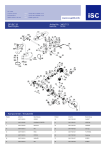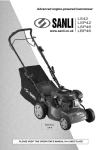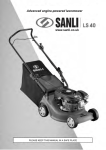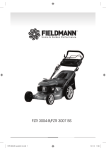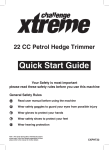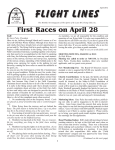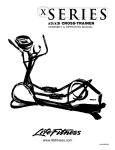Download 0151 6491500
Transcript
40cm Petrol Lawnmower SPJPM40B&S Original Operating Instructions Now that you have purchased your Spear & Jackson product, you can rest assured that as well as a 2 year manufacturer’s guarantee you also have access to a dedicated helpline and after sales service. AFTER SALES SUPPORT UK / IRELAND HELPLINE NO REP. IRELAND HELPLINE NO WEB SUPPORT 0151 6491500 1890 946244 www.einhell-uk.co.uk Art. No. 34.024.90 MODEL NUMBER: SPJPM40B&S POWERFUL 148CC BRIGGS & STRATTON 450 SERIES PETROL ENGINE Ideal for medium to large lawns 45 LITRE GRASS COLLECTION BAG 40CM METAL DECK 5 ADJUSTABLE CUTTING HEIGHTS ADJUSTABLE AND FOLDING HANDLE Large volume helps to limit emptying bag Allows for precise cutting from 25mm - 65mm Robust & long life Allows for handle to be adjustable for comfort and easy storage Attention! Caution Read the operating instructions to reduce the risk of inquiry Wear ear-muffs The impact of noise can cause damage to hearing Wear safety goggles Sparks generated during working or splinters, chips and dust emitted by the device can cause loss of sight Helpline No. UK/Northern Ireland 0151 6491500 02 Rep. Ireland 1890 946244 Helpline No. UK/Northern Ireland 0151 6491500 Rep. Ireland 1890 946244 03 Please read these instructions carefully before installing and operating the petrol lawnmower! Helpline No. UK/Northern Ireland 0151 6491500 04 Rep. Ireland 1890 946244 1 2 Helpline No. UK/Northern Ireland 0151 6491500 Rep. Ireland 1890 946244 05 3a 3b 3c 3d 4 5a Helpline No. UK/Northern Ireland 0151 6491500 06 Rep. Ireland 1890 946244 5b 6a 6b 6c 7 8 7 Helpline No. UK/Northern Ireland 0151 6491500 Rep. Ireland 1890 946244 07 9 Helpline No. UK/Northern Ireland 0151 6491500 08 Rep. Ireland 1890 946244 Table of contents 1. Safety information 2. Layout 3. Items supplied 4. Intended use 5. Technical data 6. Before starting the equipment 7. Operation 8. Cleaning, maintenance, storage, transport and ordering of spare parts 9. Disposal and recycling 10. Troubleshooting guide Page 10 11 11 12 12 12 13 16 17 18 Helpline No. UK/Northern Ireland 0151 6491500 Rep. Ireland 1890 946244 09 Important When using the equipment, a few safety precautions must be observed to avoid injuries and damage. Please read the complete operating instructions and safety information with due care. Keep these operating instructions in a safe place so that the information is available at all times. If you give the equipment to any other person, hand over these operating instructions and the safety information as well. We cannot accept any liability for damage or accidents which arise due to a failure to follow these instructions and the safety information. 1. Safety instructions for hand mower Note 1. Read the directions with due care. Familiarize yourself with the settings and proper operation of the equipment. 2. Never allow children or other persons who are not familiar with the operating instructions to use the mower. Contact your local governmental agency for information regarding minimum age requirements for the user. 3. Never mow in the direct vicinity of persons especially children - or animals. Always keep in mind that the operator or user of the equipment is responsible for accidents involving other persons and/or their property. 4. If you give the equipment to any other person, give them these operating instructions as well. Preliminary measures 1. Always wear sturdy, non-slip footwear and long trousers when mowing. Never mow barefoot or in sandals. 2. Check the ground on which the equipment will be used and remove all objects that could be caught up and violently flung out. 3. Warning: Petrol is highly flammable! Therefore: - Only store petrol in containers designed to hold petroleum-based liquids. - Only refuel out in the open and do not smoke during the refuelling process. - Always refuel the lawn mower before starting the engine. Do not open fuel tank cap and do not refuel when the engine is running or when the scythe is hot. - If petrol has overflowed, do not under any circumstances attempt to start the engine. Instead, remove the equipment from the affected area. Avoid starting the engine until the petrol fumes have completely evaporated. - For safety reasons, the petrol tank and other tank closures must be replaced if they are damaged. 4. Replace defective exhausts. 5. Before using the scythe, visually inspect it to ensure that the blade, mounting bolts and the entire cutting apparatus are in good working order (i.e. not worn out or damaged). To prevent any imbalance, replace worn out or damaged blades and mounting bolts as a set only (if applicable). Handling 1. Do not let the combustion engine run in enclosed areas, as dangerous carbon monoxide gas can build up. 2. Only mow in broad daylight or in well-lit conditions. If possible, avoid using the equipment on wet grass. 3. Always maintain good footing on inclines. 4. Only operate the machine at a walking pace. 5. For machines with wheels: Always mow across hills i.e. never straight up or straight down. 6. Be particularly careful when you change direction on a slope. 7. Do not mow on overly steep inclines. 8. Always be extra careful when turning the mower around and when pulling it towards you. 9. Switch off the lawn mower and ensure that the blade has stopped rotating whenever the mower has to be tilted for transporting over areas other than lawns and whenever it has to be moved from or to the area you want to mow. 10. Never use the lawn mower if the blade or safety grilles are damaged, or without the attached guards, e.g. deflectors and/or grass catching devices. 11. Do not adjust or overclock the engine speed settings. 12. Release the engine brake, before you start the engine. 13. Start the engine with caution as described in the manufacturer’s instructions. Make sure that your feet are far enough away from the mower blade! 14. Do not tilt the lawn mower when you start the engine unless the mower must be raised off of the ground a little in order to start it. In this case, tilt it as little as absolutely necessary and only raise the side opposite to that of the user. 15. Do not start the engine if you are positioned in front of the chute. Helpline No. UK/Northern Ireland 0151 6491500 10 Rep. Ireland 1890 946244 16. Never move your hands or feet toward or under any rotating parts. Keep clear of the chute opening at all times. 17. Never lift or carry a lawn mower with the engine running. 18. Switch off the engine and pull the spark plug boot: - before you dislodge any blockages or clogs in the chute. - before carrying out any checks, cleaning, maintenance or other work on the lawn mower. - if you have struck a foreign object. Examine the mower for signs of damage and carry out any necessary repairs before restarting and continuing to work with the mower. If the lawn mower begins to experience exceptionally strong vibrations, immediately switch it off and check it. 19. Switch off the engine: – when you leave the lawn mower - before you refuel. 20. When you switch off the engine, move the speed lever to the “Stop” position. Close the petrol cock. 21. Operating the equipment at excessive speed may increase the risk of accidents. 22. Carry out adjustment work on the equipment with care and avoid jamming your fingers between the moving blades and rigid parts of the equipment. Maintenance and storage 1. Make sure that all nuts, bolts and screws are tightened securely and that the machine is in safe working condition. 2. Never store the mower (with petrol in the tank) inside a building in which petrol fumes could come into contact with open flames or sparks. 3. Allow the engine to cool before you put the lawn mower in an enclosed area. 4. In order to avoid fire hazards, keep the engine, exhaust and the area around the fuel tank free from grass, leaves and leaking grease (oil). 5. Routinely check the grass basket for signs of wear and impaired functionality. 6. For your own safety, replace worn or damaged parts without delay. 7. If the fuel tank needs to be emptied, ensure that it is done out in the open with a petrol suction pump (available from DIY stores). CAUTION Read all the safety regulations and instructions. Any errors made in following the safety information and instructions set out below may result in an electric shock, fire and/or serious injury. Keep all safety information and instructions in a safe place for future use. Explanation of the warning signs on the equipment (see Fig. 9) 1) Read the operating instructions 2) Important. Danger from catapulted parts. Keep a safe distance. 3) Important. Switch off the engine and pull the spark plug boot before doing any maintenance, repair, cleaning or adjustment work. 4) Fill with oil and fuel before starting 5) Caution! Wear ear protection and safety goggles. 6) Engine start/stop lever (I=Engine on; 0=Engine off) 2. Layout (Fig. 1/2) 1. Engine start/stop lever (engine brake) 2. Push bar 3. Grass bag 4. Ejector flap 5. Starter cable 6. Wheel height adjustment lever (all 4 wheels) 7. Red Primer 8. Throttle control 9. Cable clip (1x) 10. Nut (4x) 11. Screw (4x) 12. Spark plug wrench 3. Items supplied Please check that the article is complete as specified in the scope of delivery. If parts are missing, please contact our service centre at the latest within 5 working days after purchasing the article and upon presentation of a valid bill of purchase. Also, refer to the warranty table in the warranty provisions at the end of the operating instructions. nOpen the packaging and take out the equipment with care. nRemove the packaging material and any packaging and/or transportation braces (if available). n Check to see if all items are supplied. nInspect the equipment and accessories for transport damage. nIf possible, please keep the packaging until the end of the guarantee period. Helpline No. UK/Northern Ireland 0151 6491500 Rep. Ireland 1890 946244 11 IMPORTANT The equipment and packaging material are not toys. Do not let children play with plastic bags, foils or small parts. There is a danger of swallowing or suffocating! nPetrol lawn mower nPush bar nGrass basket nCable clip (1x) nNut (4x) nScrew (4x) nSpark plug wrench nPetrol service manual nOriginal operating instructions 4. Proper operation The petrol lawn mower is intended for private use i.e. for use in home and gardening environments. Private use of the lawn mower refers an annual operating time generally not exceeding that of 50 hours, during which time the machine is primarily used to maintain small-scale, residential lawns and home/hobby gardens. Public facilities, sporting halls, and agricultural/forestry applications are excluded. Please note that our equipment has not been designed for use in commercial, trade or industrial applications. Our warranty will be voided if the machine is used in commercial, trade or industrial businesses or for equivalent purposes. The operating instructions as supplied by the manufacturer must be kept and referred to in order to ensure that the lawn mower is properly used and maintained. The instructions contain valuable information on operating, maintenance and servicing conditions. Important! Due to the high risk of bodily injury to the user, the lawn mower may not be used to trim bushes, hedges or shrubs, to cut scaling vegetation, planted roofs, or balcony-grown grass, to clean (suck up) dirt and debris off walkways, or to chop up tree or hedge clippings. Moreover, the lawn mower may not be used as a power cultivator to level out high areas such as molehills. For safety reasons, the lawn mower may not be used as a drive unit for other work tools or toolkits of any kind. 5. Technical data Note: The enclosed manual from Briggs & Stratton provides detailed technical data on the engine! Engine type: One-cylinder four-stroke engine, 148 ccm 2900 ± 50 min-1 Working speed n0: Fuel: Petrol Cutting height adjustment: (25-65mm) Cutting width: 400 mm Weight: (without oil) 21 kg Sound and vibration LpA sound pressure level KpA uncertainty LWA sound power level KWA uncertainty 81.2 dB(A) 3 dB 96 dB(A) 3 dB Wear ear-muffs The impact of noise can cause damage to hearing. Vibration emission value ah = 4.042 m/s2 K uncertainty = 1.5 m/s2 6. Before starting the equipment 6.1 Assembling the components Some parts of the mower need to be assembled. For quick and easy assembly, read and follow the instructions below. Important. You will need the following additional tools (not supplied) for assembly, and also for maintenance work: n13mm spanner for Handle assembly nA flat oil drip tray (for changing the oil) nA 1 litre measuring jug (oil/petrol resistant) nA petrol can nA funnel (suitable for the tank’s petrol filler neck) nA petrol suction pump (plastic, available from Einhell UK Ltd - call 0151 649 1500 (IRE 189 094 6244)) nAn oil can with hand pump (available from DIY stores) nEngine oil Helpline No. UK/Northern Ireland 0151 6491500 12 Rep. Ireland 1890 946244 Assembly 1. Take the mower and attachment parts out of the packaging and check that all parts are present (Fig. 2). 2. Fasten the push handle (Fig. 3a / Item 2) with two screws (Fig. 3a / Item 9) and two nuts (Fig. 3a / Item 8) each on either side, making sure that the cable and clip to be installed later on are not in the way. (Tighten with a 13mm spanner). 3. Unfold the push bar and fix it into place by tightening the handle clamping knobs as shown in Figure 3b. 4. Insert the grip of the starter cord (Fig. 3c/Item 5) into the hook provided for that purpose as shown in Figure 3c. 5. Fasten the cords to the push bar with the supplied cable clip (Fig. 3d/Item 9). 6. Lift the ejector flap (Fig. 4 / Item 4) with one hand and hook in the grass bag (Fig. 4/Item 3) as shown in Figure 4. 6.2 Setting the cutting height Important. Adjust the cutting height only when the engine is switched off and the plug boot has been pulled. nBefore you begin to mow, check to ensure that the blade is not blunt and that none of the fasteners are damaged. To prevent any imbalance, replace blunt and/or damaged blades as a set only (if applicable). To carry out this check, first switch off the engine and pull the spark plug boot. nThe cutting height is not adjusted at a single central point – instead, each of the 4 wheels have to be adjusted separately. Five different cutting heights are available (25, 35, 45, 55 & 65mm). (As-delivered state: Medium cutting height (45mm)) Caution: All 4 wheels have to be set to the same cutting height. 1. Use the height adjusting lever of each wheel (see Fig. 1 / It. 6 & Fig. 6a. to Fig. 6c. / It. 6) to set the lawnmower to the required height for all of the 4 wheels. 2. Each lever is sprung into one of five slot positions on the wheel bracket. Moving the lever towards the front of the lawnmower increases the blade cutting height. Moving the lever towards the rear of the lawnmower lowers the blade cutting height . 3. To adjust the lever position, pull the lever towards the wheel, out of the slot position and move it towards the front or the back of the lawnmower. Then release the lever into the desired slot position. Adjust all 4 levers to the same position. 7. Operation Note: For detailed information on the engine & oil, refer to the enclosed manual from Briggs & Stratton. Important. The engine does not come with oil in it. Therefore, be sure to add oil before starting the engine. You will also need to fill in petrol, as this is also not supplied upon delivery. In order to avoid any unintentional start-ups of the lawn mower, it comes equipped with an engine brake (Fig. 5a/Item 1) which must be pulled back before the engine can be started. When the engine control lever is released it must return to its initial position, at which point the engine automatically switches off. Before you start mowing, you should run through this operation several times in order to ensure that the machine is working properly. Whenever you need to perform any kind of adjustment and/or repair work on your lawn mower, wait until the blade has come to a complete stop. Note: 1. Engine brake (Fig. 5a/Item 1): Use the lever to stop the engine. When you release the lever the engine and the blade stop automatically (Fig. 5b). To mow, hold the lever in the working position. Before you start to mow, check the start/stop lever several times to be sure that it is working properly. Ensure that the tension cable can be smoothly operated (i.e. is not catching or kinked in any way). 2. Warning: The blade begins to rotate as soon as the engine is started. Important: Before you start the engine, move the engine brake several times to be sure that the stop cable is properly working. Note: The engine is factory set to a speed that is optimal for cutting and blowing grass into the basket and is designed to provide many years of use. 3. Check the oil level. 4. Fill the tank with petrol when it is empty, using a funnel and measuring vessel. Make sure that the petrol is clean. Helpline No. UK/Northern Ireland 0151 6491500 Rep. Ireland 1890 946244 13 Note: Use only unleaded petrol as fuel. Warning: Never use more than one safety petrol can. Do not smoke when refueling. Switch off the engine before refueling and allow the engine to cool down for a few minutes. To Start the Engine 6. Ensure that the ignition cable is connected to the spark plug. 7. Press the red primer (Fig.8 / It. 7) button 5 times 8. Stand behind the mower. Place one hand on the engine start/stop lever and pull the bars together (Fig. 5a Fig. 5b). Place the other hand on the starter handle. 9. Start the engine using the reversing starter (Fig.3c/Item 5). To do this pull the handle approx.10 – 15 cm (until you feel a resistance) and then start the engine with a sharp pull. If the engine does not start, pull the handle again. This could take up to 10 pulls. Important! Never allow the starter cord to snap back. Note: In cold weather, it may be necessary to repeat the starting process several times. 7.1 Before mowing Important information: 1. Make sure that you are properly dressed when mowing. Wear sturdy footwear; do not wear sandals or tennis shoes. 2. Inspect the blade. Blades, that are bent or otherwise damaged, must be exchanged for a genuine Einhell replacement blade. 3. Do not fill the fuel tank indoors, but rather out in the open. Use a funnel and a measuring vessel. Wipe off any spilled petrol. 4. Read and follow in the instructions in the operating manual as well as the information regarding the engine and accessory equipment. Store the manual in a place where it can be readily accessed by other users of the machine. 5. Exhaust gas is dangerous. Only start the engine out in the open. 6. Make sure that all the guards are fitted and that they are in good working order. 7. The machine should only be operated by persons who are well informed with the way it works and who are in reasonably good physical condition. 8. Mowing wet grass can be dangerous. Mow the grass when it is as dry as possible. 9. Tell other persons and children to stay away from the mower. 10. Never mow in conditions of poor visibility. 11. Pick up any loose objects and debris on the lawn prior to mowing. 7.2 Tips on mowing properly Important. Never open the chute flap when the grass bag has been detached (to be emptied) and the engine is still running. The rotating blade can cause serious injuries! Always carefully fasten the chute flap and grass basket. Switch off the engine before emptying the grass basket. Always ensure that a safe distance (provided by the length of the long handles) is maintained between the user and the mower housing. Be especially careful when mowing and changing direction on slopes and inclines. Maintain a solid footing and wear sturdy, non-slip footwear and long trousers. Always mow along the incline (not up and down). For safety reasons, the lawn mower may not be used to mow inclines whose gradient exceeds 15 degrees. Use special caution when backing up and pulling the lawn mower. Tripping hazard! 7.3 Mowing Only use a sharp blade that is in good condition. This will prevent the grass blades from fraying and the lawn from turning yellow. Try to mow in straight lines for a nice, clean look. The swaths should overlap each other by a few centimetres in order to avoid stripes. Keep the underside of the mower housing clean and remove grass build-up. Deposits not only make it more difficult to start the mower; they decrease the quality of the cut and make it harder for the machine to bag the grass. Always mow along inclines (not up and down). You can prevent the lawn mower from slipping down by holding a position at an angle upwards. Select the cutting height according to the length of the grass. If necessary, mow a number of times so that you never cut more than 4cm of grass in one go. Helpline No. UK/Northern Ireland 0151 6491500 14 Rep. Ireland 1890 946244 Switch off the engine before doing any checks on the blade. Keep in mind that the blade continues to rotate for a few seconds after the engine has been switched off. Never attempt to manually stop the blade. Regularly check to see if the blade is securely attached, is in good condition and is sharp. If the contrary is the case, sharpen the blade or replace it. In the event that the blade strikes an object, immediately switch off the lawn mower and wait for the blade to come to a complete stop. Then inspect the condition of the blade and the blade mount. Replace any parts that are damaged. Tips for proper mowing: 1. Pay attention to ensure that you do not run into or over anything that could damage the mower. The lawn mower could be damaged and/or the machine could inflict bodily injury. 2. A hot engine, exhaust or drive unit can burn the skin if touched. Thus, do not touch these parts unless the mower has been switched off for a while and you know that they have cooled down! 3. Use extra caution when mowing on inclines and steep grades. 4. Insufficient daylight or an insufficient level of artificial light is one reason not to mow. 5. Check the mower, the blade and other parts if they have struck a foreign object or if the machine vibrates more than usual. 6. Do not make any adjustments or repairs until the engine has been switched off. Pull the plug boot. 7. Pay special attention if you are mowing directly next to a street or are close by one (traffic). Always keep the grass chute pointed away from the street. 8. Avoid mowing in places where the wheels have trouble gripping or mowing is unsafe in any other way. Before you back up, ensure that nobody is standing behind you (especially little children, who are more difficult to see). 9. When mowing over thick, high grass, select the highest cutting level and mow at a slower speed. Before you remove any grass or blockages of any kind, switch off the engine and pull the plug boot. 10. Never remove any safety-related parts. 11. Never fill the engine with petrol when it is hot or is running. 7.4 Emptying the collection bag As soon as grass clippings start to trail the lawn mower, it is time to empty the grass basket. Important. Before taking off the grass basket, switch off the engine and wait until the blade has come to a stop. To take off the grass collection bag, use one hand to lift up the chute flap and the other to grab onto the basket carry-handle. Remove the basket (Fig. 4). For safety reasons, the chute flap automatically falls down after removing the grass basket and closes off the rear chute opening. If any grass remains in the opening, it will be easier to restart the engine if you pull the mower back approximately 1 metre. Do not use your hands or feet to remove clippings in or on the mower housing, but instead use suitable tools such as a brush or a hand broom. In order to ensure that the majority of grass clippings are picked up, the inside of both the grass bag and especially the air grill must be cleaned after each use. Reattach the grass bag only when the engine is switched off and the blade is stopped. Using one hand, lift up the chute flap, while grabbing onto the basket handle with the other. Hang in the basket from the top. 7.5 After mowing 1. Allow the engine to cool before you put the lawn mower in an enclosed area. 2. Remove grass, foliage, grease and oil before storing the mower. Do not place any objects on top of the mower. 3. Before using the mower again, retighten all nuts and screws. Tighten all screws which were slackened. 4. Also be sure to empty the grass basket. 5. Disconnect the spark plug boot to prevent unauthorized use. 6. Ensure that you do not park the mower next to any source of danger. Petrol fumes can lead to explosions. 7. Only original parts or parts approved by the manufacturer may be used for repairs (see address on the warranty certificate). 8. Empty the petrol tank with a petrol extraction pump if you are not intending to use the mower for an extended period of time. 9. Tell your children not to use the mower. It is not a toy. Helpline No. UK/Northern Ireland 0151 6491500 Rep. Ireland 1890 946244 15 10. Never place petrol near an ignition source. Always use a can that is approved to store petrol. Keep petrol away from children. 11. Oil and maintain the machine. 12. How to switch off the engine: All you have to do to switch off the engine is release the engine start/stop lever (Fig. 5a/Item 1). Pull the ignition cable from the spark plug boot in order to prevent the engine from restarting. Before you start the engine again, check the cord for the engine brake. Check that the cord is correctly fitted. If the cord is kinked or damaged, it should be replaced. 8. Cleaning, maintenance, storage, transport and ordering of spare parts Important: The enclosed engine manual from Briggs & Stratton provides maintenance information and maintenance interval information on the engine. Important: Never work on or touch conducting parts on the ignition unit with the engine running. Always pull the spark plug boot from the spark plug before starting any cleaning or maintenance. Never perform any work on the machine while it is running. Any work not described in these Operating Instructions must be performed by an authorized service workshop only. 8.1 Cleaning After each use, the mower should be thoroughly cleaned (especially the underside and blade receptacle). Note: Before you tilt the lawnmower onto its side, empty the fuel tank completely with a petrol pump. The lawnmower must not be tilted more than 90 degrees. The simplest time to remove dirt and grass is directly after mowing. Dried residual grass and dirt could cause damage to the mowing operation. Make sure the grass ejector canal is free from residual pieces of grass and remove these if necessary. Never clean the mower with a direct jet of water or a high pressure cleaner. The motor must stay dry. Aggressive cleaning agents such as cold cleaning solvent or petroleum ether must not be used. 8.2 Maintenance Dispose of soiled maintenance material and operating materials at the appropriate waste collection point. 8.2.1 Wheel axles and wheel hubs A thin coating of grease should be applied to the axles and wheel hubs once per season. To do so, remove the wheel caps with a screwdriver and remove the circlip and washer to allow the wheel removal. 8.2.2 Blade For safety reasons you should only ever have your blade sharpened, balanced and mounted by a service workshop. For optimum results it is recommended that the blade should be inspected once a year. Changing the blades (Fig. 7) Only ever use original spare parts when having the blade replaced. The marking on the blade must be matched with the number given in the list of spare parts. Never have any other model of blade fitted. Damaged blades Should the blade, in spite of all precautions, come into contact with an obstruction, shut down the engine immediately and pull the spark plug boot. Tip the lawn mower onto its side and check the blade for damage. Damaged or bent blades must be replaced. Never attempt to bend a bent blade back to straight again. Never mow the lawn with a bent or heavily worn blade as this will cause vibrations and can lead to further damage to the lawn mower. Important: There is a risk of injury if you work with a damaged blade. Resharpening the blade The blades can be resharpened with a metal file. In order to avoid imbalance, the blade should be resharpened by a service workshop. 8.2.3 Care and adjustment of the brake cable Oil the brake cable inner wire at regular intervals and check that it moves easily within the outer sheath. Helpline No. UK/Northern Ireland 0151 6491500 16 Rep. Ireland 1890 946244 8.2.4 Repairs After any repair or maintenance work, check that all safety-related parts are in place and in proper working order. All parts which may cause injury must be kept where they are inaccessible to children or others. Important: In accordance with product liability legislation we are not liable for any damages caused by improper repairs or the use of spare parts that are not original spare parts or parts approved by us. In addition, we are also not liable for any damages arising from improper repairs. Such work should be performed by a customer services workshop or authorized specialist. The same applies to accessory parts. 8.2.5 Times of use Please comply with statutory regulations, which may vary from location to location. 8.3 Preparing the mower for long-term storage Caution: Do not empty the petrol tank in enclosed areas, near fire or when smoking. Petrol fumes can cause explosions and fire. 1. Empty the petrol tank with a petrol suction pump. 2. Start the engine and let it run until any remaining petrol has been used up. 3. Remove the spark plug from the cylinder head. Use an oil can to fill the cylinder with approx. 20 ml of oil. Slowly pull back the starter handle, which will bathe the cylinder wall with oil. Screw the spark plug back in. 4. Clean the cooling fins of the cylinder and the housing. 5. Be sure to clean the entire machine to protect the paint. 6. Store the machine in a well-ventilated place. 7. Wedge a few layers of corrugated cardboard between the upper and lower push bars and the engine in order to prevent any chafing. 8.5 Consumables, wear materials and spare parts Spare parts, consumables and wear materials such as engine oil, V-belts, spark plugs, air filter inserts, petrol filters, batteries and blades are not covered by the warranty. 8.6 Ordering replacement parts Please quote the following data when ordering replacement parts: • Type of machine SPJPM 40 • Article number of the machine 34.024.90 • Identification number of the machine 11010 • Replacement part number of the part required 9. Disposal and recycling The unit is supplied in packaging to prevent its being damaged in transit. This packaging is raw material and can therefore be reused or can be returned to the raw material system. The unit and its accessories are made of various types of material, such as metal and plastic. Defective components must be disposed of as special waste. Ask your local council for information. 8.4 Preparing the mower for transport 1. Empty the petrol tank (refer to point 8.3/1) 2. Always let the engine run until it has used up the remainder of petrol in the tank. 3. Empty the engine oil from the warm engine. 4. Remove the spark plug boot from the spark plug. 5. Clean the cooling fins of the cylinder and the housing. 6. Unhook the starter cable from the hook (Fig. 3c). Slacken the handle clamping knobs and fold down the upper push bar. Make sure that the cables do not get kinked when the bar is pulled up. Helpline No. UK/Northern Ireland 0151 6491500 Rep. Ireland 1890 946244 17 10. Faults and remedies for faults Caution: Always switch off the engine and pull the ignition cable before starting any inspection or adjustment work. Caution: If, after making an adjustment or repair to the engine, you let it run for a few minutes, remember that the exhaust and other parts will get hot. Thus, do not touch parts that emanate heat, as these may burn you. Important. If problems arise in connection with the engine, please refer to the enclosed manual from Briggs & Stratton. Fault Probable cause Remedy - Screws are loose - Check screws - Blade fasteners are loose - Check blade fasteners - Blade is unbalanced - Replace blade - Brake lever not pressed - Press brake lever - Fuel tank empty - Top up fuel Lawn turns yellow, uneven cut - Blade is blunt - Sharpen the blade - Cutting height is too low - Set correct height Grass chute is not clean - Cutting height is too low - Set correct height - Blade is worn - Replace the blade - Grass bag is clogged - Empty the grass bag Loud while running, machine vibrates heavily The engine does not start Helpline No. UK/Northern Ireland 0151 6491500 18 Rep. Ireland 1890 946244 Guarantee Certificate Dear Customer, In the unlikely event that your device develops a fault, please contact our Customer service department on the telephone number shown below. 1. These guarantee terms cover additional guarantee rights and do not affect your statutory warranty rights. Claims must be accompanied by Proof of Purchase. This must be in the form of a Sales receipt or Bank statement and must show that the product has been purchased within 2 years prior to the claim from the retailer that it was originally sold to. 2. Our guarantee covers problems caused by material or manufacturing defects, and will result in the repair of these defects or replacement of the device with a like for like or similar article. Please note that our devices have not been designed for use in commercial, trade or industrial applications. Consequently, the guarantee is invalidated if the equipment is used in commercial, trade or industrial applications or for other equivalent activities. 3. The following are also excluded from our guarantee: A) Faults due to accidents, customer misuse, or unauthorized repairs B) Consumable Parts such as Blades/Chains/Trimmer lines/Spools/Vacuum bags/Spark plugs or Filters C) Failure due to lack of routine maintenance D) Failure as a result of not using the equipment in accordance with the manual and safety instructions E) The adjustment or lubrication cables, drive belts, or recoil starters 4. The guarantee is valid for a period of 2 years starting from the purchase date of the device. Guarantee claims should be submitted before the end of the guarantee period within two weeks of the defect being noticed. No guarantee claims will be accepted after the end of the guarantee period. The original guarantee period remains applicable to the device even if repairs are carried out or parts are replaced. In such cases, the work performed or parts fitted will not result in an extension of the guarantee period, and no new guarantee will become active for the work performed or parts fitted. This also applies when an on-site Service is used. 5. Please keep your sales receipt in a safe place. If the defect is covered by our guarantee your device will either be repaired under the terms of guarantee or we will send you a replacement device. This device may be re-conditioned or Like for like replacement. EINHELL UK LTD HELPLINE: + 44 151 649 1500 REP. IRELAND HELPLINE: 1890 946244 HOME RETAIL GROUP 489-499 AVEBURY BOULEVARD, SAXON GATE WEST, CENTRAL MILTON KEYNES, MK9 2NW Helpline No. UK/Northern Ireland 0151 6491500 Rep. Ireland 1890 946244 19 Please adhere to the following maintenance periods in order to ensure a failure-free operation. Important! Fill up with engine oil and fuel before starting up the engine for the first time. Before each use Check the engine oil After an operating period of 20 hours After an operating period of 50 hours After an operating period of 100 hours After an operating period of 300 hours X for the first time Change the engine oil then every 100 X hours Change the Check the air filter filter element if X Clean the air filter necessary X Clean the petrol filter Visual inspection of the unit Clean the spark plug X X Distance: 0.6mm, Replace if necessary Check and readjust the carburetor's throttle valve X* Clean the cylinder head X* Set the valve clearance X* Important: The positions marked with "X*" should only be carried out by an authorized dealer. Helpline No. UK/Northern Ireland 0151 6491500 20 Rep. Ireland 1890 946244 Declaration of Conformity Helpline No. UK/Northern Ireland 0151 6491500 Rep. Ireland 1890 946244 21 Notes Helpline No. UK/Northern Ireland 0151 6491500 22 Rep. Ireland 1890 946244 The reprinting or reproduction by any other means, in whole or in part, of documentation and papers accompanying products is permitted only with the express consent of ISC GmbH. Technical changes subject to change Helpline No. UK/Northern Ireland 0151 6491500 Rep. Ireland 1890 946244 23 AFTER SALES SUPPORT UK / IRELAND HELPLINE NO REP. IRELAND HELPLINE NO WEB SUPPORT 0151 6491500 1890 946244 www.einhell-uk.co.uk Art No: 34.024.90 MODEL NUMBER: SPJPM40B&S

























